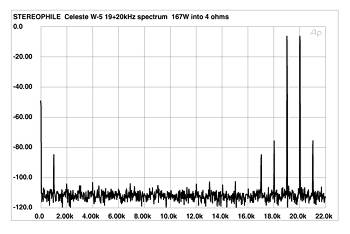| Columns Retired Columns & Blogs |
Simaudio Moon P-5 preamplifier & W-5 power amplifier part 3
Fig.11, the output spectrum with a combined 19+20kHz signal at 167W into 4 ohms, indicates the intermodulation products resulting from an input signal consisting of an equal combination of these two frequencies. Visible clipping is present above 167W into this load with this input signal. The IM here is quite low—a maximum of -69.4dB, or just over 0.03%, at 18kHz. The result into an 8 ohm load for the same test (at 94W) was virtually identical and is not shown.

Fig.11 Moon W-5, HF intermodulation spectrum, DC-22kHz, 19+20kHz at 167W into 4 ohms (linear frequency scale).
The 1kHz, THD+noise vs output curves for the W-5 are shown in fig.12. The discrete clipping levels are shown in Table 1. When I attempted to perform discrete clipping measurements on the W-5 at lower load impedances, its main power-supply fuses blew—several times. SimAudio uses fast-blow fuses in its main power circuit to protect the amplifier against overload. While the sort of overloads provided by music should not present a problem with these fuses, they do limit the time high-power test-bench signals can be sustained. It normally takes about two seconds to engage the test signal, wait for the instruments to stabilize, and note the reading—too long for the Moon's fuses at 4 or 2 ohms. The sweep tests in fig.12 are generally less stressful on an amplifier. SO the figures shown into the lower impedance in Table 1 are taken from the these.

Fig.12 Moon W-5, distortion (%) vs continuous output power into (from bottom to top): 8 ohms, 4 ohms, 2 ohms.
JA used the Miller Audio Research Amplifier Profiler to examine the Moon W-5's output power using a low-duty-cycle 1kHz toneburst (10 cycles on, 40 cycles off). This signal stresses the amplifier less than the continuous signal and gives a result more representative of how an amplifier behaves with a music signal. As can be seen from fig.13, the Moon amplifier proved to be a powerhouse on this test, almost doubling its power delivery each time the load impedance was halved. For a standard 1% THD+Noise, it delivered 233W into 8 ohms (black trace), 460W into 4 ohms (red), 865W into 2 ohms (blue), and a staggering 1480W into 1 ohm (green). No wonder Kal Rubinson found the Moon W-5 to control the bass panels of his Apogee Duettas so well.—Thomas J. Norton

Fig.13 Moon W-5, distortion (%) vs burst output power into (from bottom to top): 8 ohms (black trace), 4 ohms (red), 2 ohms (blue) and 1 ohm (green).
| Table 1 SimAudio Celeste W-5 Discrete Clipping Levels (1% THD+noise at 1kHz) | |||
| Both Channels Driven W (dBW) | One Channel Driven W (dBW) | ||
| ohms | L | R | L |
| 8 | 189.2 (22.8) | 188.2 (22.7) | 196.2 (22.9) |
| 120V | 120V | 121V | |
| 4 | 330 (22.2) | ||
| 2 | 520 (21.1) | ||
- Log in or register to post comments




































